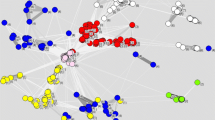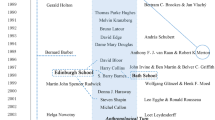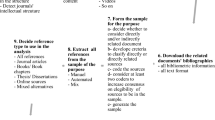Abstract
The notion of ‘core documents’, first introduced in the context of co-citation analysis and later re-introduced for bibliographic coupling and extended to hybrid approaches, refers to the representation of the core of a document set according to given criteria. In the present study, core documents are used for the identification of new emerging topics. The proposed method proceeds from independent clustering of disciplines in different time windows. Cross-citations between core documents and clusters in different periods are used to detect new, exceptionally growing clusters or clusters with changing topics. Three paradigmatic types of new, emerging topics are distinguished. Methodology is illustrated using the example of four ISI subject categories selected from the life sciences, applied sciences and the social sciences.






Similar content being viewed by others
References
Batagelj, V., & Mrvar, A. (2003). Pajek—Analysis and visualization of large networks. In M. Jünger & P. Mutzel (Eds.), Graph drawing software (pp. 77–103). Berlin: Springer.
Boyack, K. W., & Klavans, R. (2010). Co-citation analysis, bibliographic coupling, and direct citation: Which citation approach represents the research front most accurately? Journal of the American Society for Information Science and Technology, 61(12), 2389–2404.
Braam, R. R., Moed, H. F., & van Raan, A. F. J. (1991a). Mapping of science by combined cocitation and word analysis, part 1: Structural aspects. Journal of the American Society for Information Science, 42(4), 233–251.
Braam, R. R., Moed, H. F., & van Raan, A. F. J. (1991b). Mapping of science by combined cocitation and word analysis, part II: Dynamical aspects. Journal of the American Society for Information Science, 42(4), 2–266.
Glänzel, W., & Czerwon, H. J. (1996). A new methodological approach to bibliographic coupling and its application to the national, regional and institutional level. Scientometrics, 37, 195–221.
Glänzel, W., & Thijs, B. (2011a). Using ‘core documents’ for the representation of clusters and topics. Scientometrics, 88(1), 297–309.
Glänzel, W. & Thijs, B. (2011b). Using ‘core documents’ for detecting new emerging topics. In E. Noyons, P. Ngulube, J. Leta (Eds.), Proceedings of ISSI 2011—The 13th International Conference on Scientometrics and Informetrics, Durban, South Africa (pp. 224–235). KwaDlangezwa: University of Zululand.
Glenisson, P., Glänzel, W., Janssens, F., & de Moor, B. (2005). Combining full text and bibliometric information in mapping scientific disciplines. Information Processing & Management, 41(6), 1548–1572.
Hicks, D. (1987). Limitations of co-citation analysis as a tool for science policy. Social Studies of Science, 17, 295–316.
Jo, Y., Lagoze, C. & Giles, C. L. (2007), Detecting research topics via the correlation between graphs and texts. In KDD-2007 Proceedings of the 13th ACM SIGKDD International Conference on Knowledge Discovery and Data Mining (pp. 370–379). San Jose.
Lamirel, J. C., Ta A. P., Attik, M. (2008). Novel labeling strategies for hierarchical representation of multidimensional data analysis results. In A. Gammerman (Ed.), Proceedings of the 26th IASTED International Conference on Artificial Intelligence and Applications, Austria (pp. 169–174), 11–13 February 2008. Innsbruck, Austria: ACTA Press.
Lamirel, J. C., Safi, Gh., Pryankar, N., & Cuxac, P. (2010). Mining research topics evolving over time using a diachronic multi-source approach. The Fourth International Workshop on Mining Multiple Information Sources—ICDM 2010. Kansas City.
Leydesdorff, L. (2006). Can scientific journals be classified in terms of aggregated journal–journal citation relations using the Journal Citation Reports? Journal of the American Society for Information Science and Technology, 57(5), 601–613.
Liu, X., Yu, S., Janssens, F., Glänzel, W., Moreau, Y., & De Moor, B. (2010). Weighted hybrid clustering by combining text mining and bibliometrics on large-scale journal database. Journal of the American Society for Information Science and Technology, 61(6), 1105–1119.
Rousseeuw, P. J. (1987). Silhouettes: A graphical aid to the interpretation and validation of cluster analysis. Journal of Computational and Applied Mathematics, 20, 53–65.
Sen, S. K., & Gan, S. K. (1983). A mathematical extension of the idea of bibliographic coupling and its applications. Annals of Library Science and Documentation, 30, 78–82.
Shibata, N., Kajikawa, Y., Takeda, Y., & Matsushima, K. (2008). Detecting emerging research fronts based on topological measures in citation networks of scientific publications. Technovation, 28(11), 758–775.
Small, H. (1973). Cocitation in scientific literature—New measure of relationship between 2 documents. Journal of the American Society for Information Science, 24(4), 265–269.
Zhang, L., Glänzel, W., & Liang, L. (2009). Tracing the role of individual journals in a cross-citation network based on different indicators. Scientometrics, 81(3), 821–838.
Zitt, M., & Bassecoulard, E. (1994). Development of a method for detection and trend analysis of research fronts built by lexical or cocitation analysis. Scientometrics, 30(1), 333–351.
Acknowledgments
The present study is an extended version of a article presented at the 13th International Conference on Scientometrics and Informetrics, Durban (South Africa), 4–7 July 2011 (Glänzel and Thijs 2011a, b). Methodology has partially been developed in the context of the ERACEP project within the Coordination and Support Actions (CSAs) of the European Research Council (ERC) work programme. The authors wish to acknowledge this support.
Author information
Authors and Affiliations
Corresponding author
Rights and permissions
About this article
Cite this article
Glänzel, W., Thijs, B. Using ‘core documents’ for detecting and labelling new emerging topics. Scientometrics 91, 399–416 (2012). https://doi.org/10.1007/s11192-011-0591-7
Received:
Published:
Issue Date:
DOI: https://doi.org/10.1007/s11192-011-0591-7




